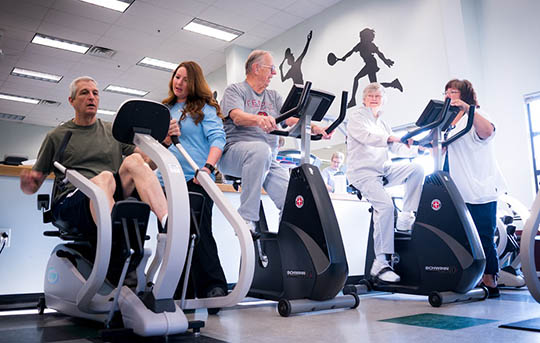Exercise often comes to mind when we’re trying to lose a few pounds and look our best, but one benefit that comes from a regular exercise routine is the positive impact on our heart health. Physical activity has numerous benefits including weight loss, stress reduction, and an increase in energy all while reducing our chance of heart disease – the leading cause of death in the United States for both men and women.

Cardiovascular exercise includes a variety of workouts
including biking, walking, swimming, running and many others.
Shawn M. Hoch, MS, Clinical Manager of Cardiopulmonary Rehabilitation at Chester County Hospital, explains one reason why exercise is so good for our heart, “Over time, regular exercise helps increase your heart’s efficiency, allowing it to pump more blood volume per heartbeat, reducing the amount of work your heart needs to do to get the same amount of blood flow through your body.”
Hoch also explains that exercise can help raise good cholesterol (HDL) while lowering bad cholesterol (LDL), keeping arteries that feed the heart muscle clear of plaque build-up. In addition, staying physically active will lower your blood pressure and will reduce your weight – helping you achieve your original goal of looking better while reducing the strain on your heart.
The American Heart Association recommends getting at least 30 minutes of moderate to vigorous exercise most days of the week. Moderate to vigorous exercise is considered any activity that elevates your heart rate to the target heart rate zone.
If you are not exercising regularly yet, don’t worry. Any amount of physical activity is beneficial. Gradually make your workouts longer and tougher and increase the amount of days per week you exercise to meet this recommendation.
Your Target Heart Rate
The American Heart Association recommends including exercise that increases your heart rate between 50 to 85 percent of your maximum heart rate – this is called the target heart rate zone.
For those who do not have heart disease and who are not on cardiac medication, there is a simple formula to calculate this range. Your maximum heart range is 220 beats per minute minus your age.
For example, a 50-year-old person’s maximum heart rate would be 170 (50 subtracted from 220). A 50-year-old would then multiply their maximum heart rate of 170 by .50 and .85 to get this range – 170 X .50 = 85 and 170 X .85 = 144.5. Their target heart rate zone would be between 85 – 145.
Before You Get Started
It is always a good idea to speak with your doctor before starting an exercise program. Your physician will be able to give you specific advice if you have a health condition, such as heart disease, asthma, diabetes, arthritis, cancer, or specific joint issues. There is no one-size-fits-all solution when it comes to finding the right exercise plan. Your health care provider will be able to provide the best recommendation for your health.
Listen to Your Body
It's normal to feel muscle soreness when you first start working out. It will fade over a few days and will decrease as you get use to exercising. If you have any sudden or severe pain, such as chest pain, weakness, pressure or pain in your chest, neck, arm, jaw or shoulder, or feel dizzy or light-headedness, stop exercising right away. If these symptoms, continue call your doctor or 9-1-1.
Learn about your risk of heart disease by taking an online cardiac risk assessment, such as Chester County Hospital’s “Heart Tracks.” It allows you to compare your actual age to your heart’s biological age, estimate your risk of developing cardiovascular disease and prioritize your most harmful cardiovascular risk factors. Take the assessment now!